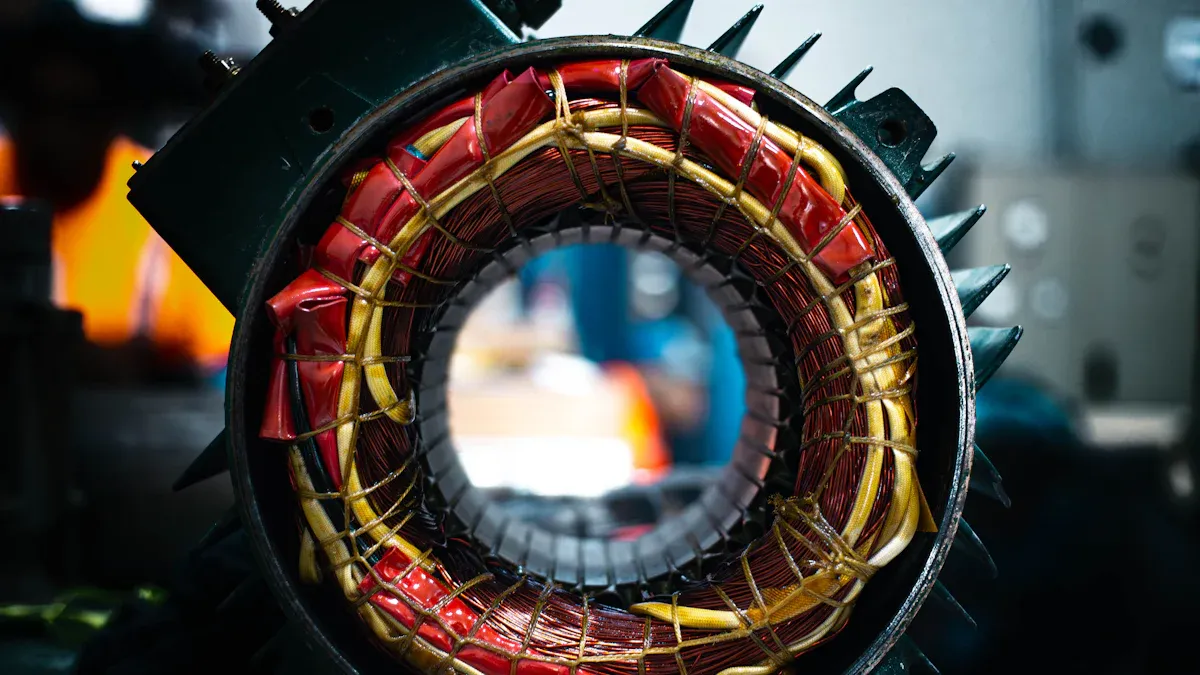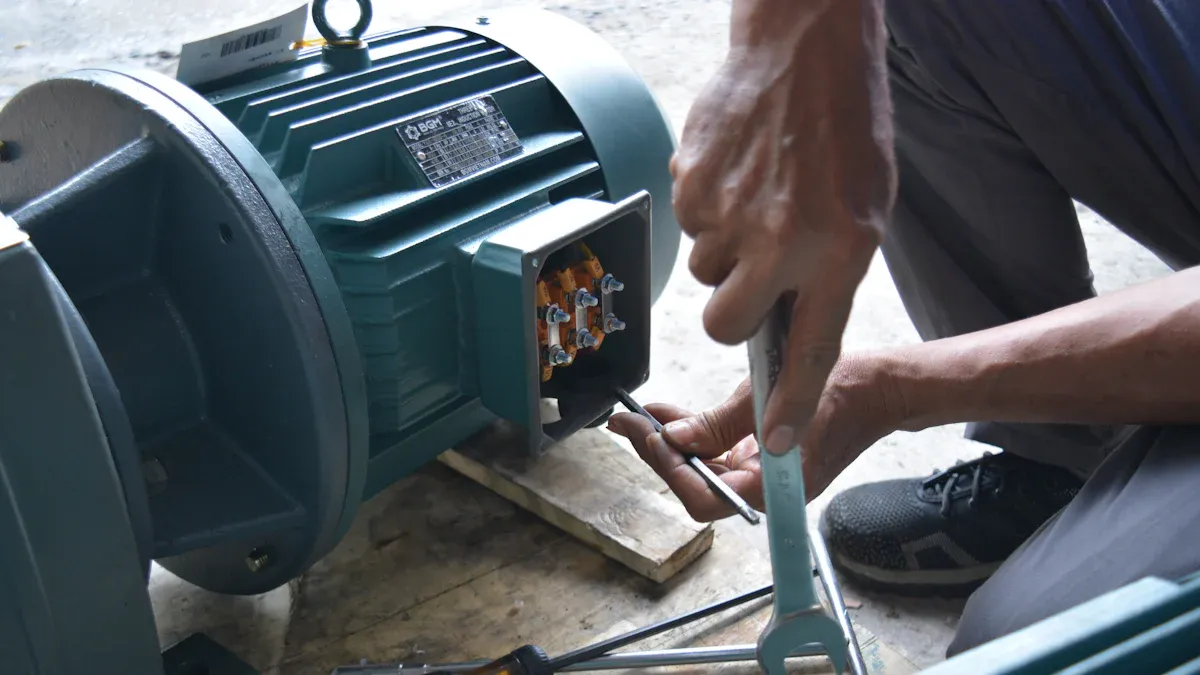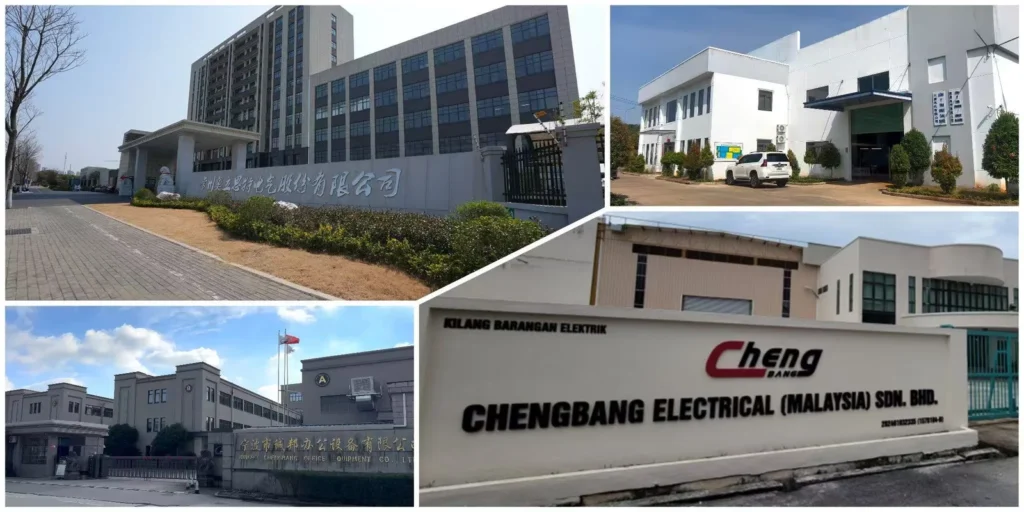AC vs DC Motors: Core Differences and Selection Guide

Choosing between AC vs DC motors can be tricky. Each type has special strengths for different jobs. AC motors work well with high power, like running electric cars far. DC motors give strong starting power, helping quick starts or careful control in machines.
Knowing these differences helps you pick the right motor. So, what makes AC vs DC motors different? How do you choose the best one for your needs? Let’s find out.
Key Takeaways
- AC motors work well for tough jobs because they are strong and efficient. They need less care and last longer, saving money for factories.
- DC motors are great for jobs needing exact control and fast starts. They are good for portable tools but need more care because of their brushes.
- Knowing the power type is important. AC motors use alternating current, which is good for steady power. DC motors use direct current, which works better for changing speeds.
- Think about how much torque and speed your job needs. AC motors keep a steady speed even with heavy loads. DC motors are better for tasks needing quick speed changes.
- Look at long-term costs like care and energy use. AC motors usually cost less to run. Brushless DC motors are efficient and need less upkeep.
Overview of AC and DC Motors
What Are AC Motors?
AC motors use alternating current (AC), which switches direction often. These motors are popular in industries because they handle strong power and force. Nikola Tesla created the AC induction motor, changing how electricity is used. It made sending power far distances easier and boosted factory work. Today, AC motors are key in HVAC systems, electric cars, and factory machines.
AC motors last long and need little care. They don’t use brushes or commutators, so parts wear out less. You can change their speed by adjusting the input frequency with a variable frequency drive (VFD). This makes them great for jobs needing steady speed and high efficiency.
What Are DC Motors?
DC motors use direct current (DC), which flows in one direction. These motors are great for controlling speed and starting with strong force. Batteries or AC-to-DC converters often power them, making them good for portable tools and machines needing speed changes.
DC motors are used in robots, conveyor belts, and electric tools. Unlike AC motors, they have brushes and commutators to move energy to the rotor. This design gives better control but needs more upkeep. Even so, DC motors are perfect for quick starts and precise movements.
Key Components of Motors
Both AC and DC motors have main parts that make them work:
- Rotor: Spins to create mechanical energy.
- Stator: Stays still and makes the magnetic field.
- Bearings: Help the rotor spin smoothly.
- Housing: Keeps the inside parts safe.
AC motors use induction or synchronous systems, while DC motors use brushes and commutators. These differences affect how efficient, long-lasting, and easy to maintain they are.
| Metric | AC Motor | DC Motor |
|---|---|---|
| Power Source | Alternating current | Direct current from batteries or converters |
| Efficiency | High at steady speeds | High at changing speeds |
| Speed Control | Changed by input frequency | Managed by armature current |
| Maintenance Needs | Lower due to fewer moving parts | Higher due to brushes and commutators |
| Applications | Strong power and force tasks | Fast and portable tasks |
| Lifespan | Longer without brushes and commutators | Shorter due to brush wear |
Knowing these parts helps you pick the right motor. AC motors are tough and efficient, while DC motors are precise and easy to control.
Types of DC Motors
DC motors come in different types for specific jobs. Knowing these types helps you pick the right one. Below is a simple table showing common DC motor types:
| Type of DC Motor | Features | Uses |
|---|---|---|
| Compound DC Motors | Mixes magnetic effects for better torque control | Heavy-duty tasks needing strong starts |
| Brushless DC Motors | No brushes; uses electronics for efficiency | Drones, medical tools, electric cars |
| Servo DC Motors | Uses feedback for exact control | Robots, CNC machines, automated systems |
| Brushed DC Motors | Older design; works with variable speed | Tools and machines needing speed changes |
| Self-excited DC Motors | Includes shunt, series, and compound designs | Special machines with unique needs |
Compound DC motors combine series and shunt designs. They give strong torque and precise speed control, great for tough jobs. Brushless DC motors skip brushes and use electronics. This makes them efficient and easy to maintain, perfect for drones and electric cars.
Servo DC motors are very accurate. They use feedback to adjust performance, ideal for robots and automation. Brushed DC motors are simple but flexible. They work well in tools needing speed changes. Self-excited DC motors, like shunt and series types, are made for special industrial tasks.
Key Differences Between AC and DC Motors

Power Source
The power source is a big difference between AC and DC motors. AC motors use alternating current, which switches direction often. This type of electricity is common in homes and factories. It makes AC motors great for big machines like HVAC systems. DC motors, however, use direct current, where electricity flows one way. Batteries, solar panels, or converters power DC motors. This makes them perfect for portable tools and devices needing precise control.
AC motors are better for jobs needing steady power over time. DC motors work best for tasks needing quick starts or speed changes. Picking the right motor depends on the power source your job needs.
Construction and Complexity
AC and DC motors are built differently, which affects how complex they are. AC motors have fewer moving parts and a simpler design. They use induction or synchronous systems, so they don’t need brushes. This makes them last longer and need less care.
DC motors have brushes and a commutator to move power to the rotor. This design gives better control of speed and force. But it also makes DC motors more complex and harder to maintain. Brushes wear out and need replacing. If you want a motor that’s tough and easy to care for, choose AC. If you need precise control and don’t mind upkeep, go with DC.
Speed Control
Speed control is another big difference between AC and DC motors. AC motors change speed by adjusting the input frequency. A variable frequency drive (VFD) helps them run smoothly and efficiently. This is great for jobs needing steady performance. DC motors change speed by adjusting the armature or field current. This makes them quick to respond and good for tasks needing fast changes.
Modern technology improves speed control for both types. AC motors use methods like voltage control and phase control for steady performance. These designs are also smaller and cheaper. DC motors use advanced techniques like Pulse Width Modulation (PWM) and Field-Oriented Control (FOC). These make DC motors precise and efficient, perfect for robots and electric cars.
| Feature | Description |
|---|---|
| Voltage Control | Adjusts AC voltage for simple speed control. |
| Closed-loop Phase Control | Keeps speed steady even in tricky conditions. |
| Compact Design | Removes big parts, making motors smaller and cheaper. |
Think about how much speed control your job needs. AC motors are great for steady, long-term tasks. DC motors are better for quick and precise speed changes.
Torque Characteristics
Torque is important when comparing how AC and DC motors work. It shows how well a motor handles load changes and keeps working smoothly. AC motors, especially induction ones, keep a steady speed even if the load changes. This makes them great for jobs like running conveyor belts or HVAC systems. DC motors, however, have a direct link between torque and current. This gives them better control, making them perfect for tasks like robotics or electric cars where accuracy matters.
The table below shows the main torque features of AC and DC motors:
| Characteristic | AC Motors (Induction) | DC Motors |
|---|---|---|
| Speed Stability under Load | Stays steady even with load changes | Changes with load |
| Torque vs Current Relationship | Not direct | Direct |
| Maximum Torque Behavior | Torque rises and stays steady | Torque drops as speed increases |
Think about your torque needs when picking a motor. AC motors are best for steady jobs with changing loads. DC motors are better for tasks needing exact torque control.
Maintenance and Durability
How much care a motor needs and how long it lasts are key factors. AC motors need less care because they are simpler. They don’t have brushes or commutators, which often wear out in DC motors. This makes AC motors last longer and cost less to maintain. DC motors, on the other hand, need regular care to replace brushes and check the commutator. But newer brushless DC motors need much less maintenance than older ones.
Here are some trends about motor care in factories:
- Over half of factories replace motors under 30 horsepower instead of fixing them.
- Of the motors sent for repair, 79% could be fixed. About 49% needed mechanical fixes, and 30% needed electrical rewinds.
- Mechanical fixes are happening more, while electrical rewinds are happening less.
If you want a motor that lasts long and needs little care, go with AC. If you need precise control and don’t mind more upkeep, DC motors are a good choice.
Cost and Efficiency
Cost and efficiency are big factors when choosing a motor. AC motors usually cost less to buy and maintain. They are also more efficient at steady speeds, saving energy over time. DC motors cost more upfront and need more care. But they offer great control over speed and torque. Their efficiency depends on how and where they are used.
The table below compares AC and DC motors for cost and efficiency:
| Motor Type | Initial Cost | Maintenance Cost | Operational Efficiency |
|---|---|---|---|
| DC Motors | Higher | Higher | Depends on use |
| AC Motors | Lower | Lower | Usually higher |
When thinking about cost and efficiency, look at both short-term and long-term needs. AC motors are cheaper and work well for steady tasks. DC motors cost more but are great for jobs needing precise control.
Application-Based Comparison of Motors

Advantages of AC Motors in Applications
AC motors are great for tough jobs needing strength and efficiency. Their simple design has fewer parts, so they last longer and need less care. Industries like food processing and wastewater treatment use AC motors because they handle heavy work well. For example, the AC motor market was worth $16.46 billion in 2021. It may grow to $22.05 billion by 2030, thanks to demand in big machines and oil industries.
AC motors are also perfect for tasks needing steady speed. Variable frequency drives (VFDs) help control speed exactly, making them useful for conveyor belts and HVAC systems. They save energy at constant speeds, cutting costs over time. This makes them a smart choice for long-term use.
Advantages of DC Motors in Applications
DC motors are very precise, making them great for jobs needing speed changes. They start with strong force, so they’re used in electric cars, robots, and motorbikes. Studies show DC motors keep steady speeds even when loads change, proving they’re reliable.
Modern brushless DC motors avoid electromagnetic problems, making them better for special industries. They’re used in tethered drones (tUAVs) and systems like electromagnetic catapults. DC motors are small and flexible, so they’re also popular in portable tools and electric bikes.
Industry-Specific Use Cases
Different industries use AC and DC motors based on their needs:
- Automotive Industry: DC motors power electric cars and automatic gears reliably.
- Manufacturing: AC motors are best for factory machines handling heavy loads.
- Aerospace: Brushless DC motors are used in drones for power line checks.
- Consumer Electronics: DC motors work well in electric bikes and small tools.
- Energy Sector: AC motors are key in oil and gas work for steady performance.
These examples show how picking the right motor improves work and saves time.
Selection Guide for Picking the Right Motor
Checking Power and Efficiency Needs
To choose a motor, know your power and efficiency needs. These decide how well the motor works and how much energy it uses. Look at key factors like speed, torque, efficiency, and power output.
- Speed: Shows how fast the motor runs, measured in RPM.
- Torque: Measures the turning force, shown in Newton-meters (Nm).
- Efficiency: Tells how well the motor turns electricity into movement.
- Power Output: Shows the work done over time, measured in watts (W).
| Metric | What It Means |
|---|---|
| Speed | How fast the motor runs under different loads (RPM). |
| Torque | The turning force the motor creates (Nm). |
| Efficiency | How well the motor changes electrical energy into mechanical power. |
| Power Output | The amount of work the motor does in a set time (W). |
Efficient motors use less energy and save money over time. Both AC and DC motors lose some efficiency when converting energy. A motor with high efficiency lowers costs and uses less power. Think about how efficient the motor is and if it fits your needs.
Tip: For steady power over long periods, pick an AC motor. For quick starts or changing speeds, a DC motor works better.
Thinking About Speed and Torque Needs
Speed and torque are key to how a motor performs. Torque-speed curves show how these two work together. They explain the motor’s limits based on its design and energy input. These curves also show how torque changes with speed.
Stepper motors have special torque-speed curves for detailed analysis. These curves help compare motors and find the right one. Higher voltage can boost torque at faster speeds. But the motor controller and power supply must match to avoid problems.
- Stepper motors have clear torque-speed curves for analysis.
- Torque-speed curves show how torque changes at different speeds.
- Matching the controller and power supply ensures smooth operation.
Pick a motor that meets your speed and torque needs with extra room for safety. AC motors are great for steady speeds under changing loads, like in HVAC systems. DC motors are better for tasks needing precise torque, like robots or electric cars.
Looking at Maintenance and Cost
Maintenance and cost are important when choosing a motor. AC motors need less care because they are simpler. They don’t have brushes or commutators, which wear out in DC motors. This makes AC motors last longer and cost less to maintain.
Follow these steps to check maintenance and cost:
| Step | What to Do |
|---|---|
| 1 | Look at past maintenance records and failure reports for the motor. |
| 2 | Add up repair costs, including parts and labor. |
| 3 | Compare replacement costs, including delivery and setup. |
| 4 | Think about downtime and safety risks during repairs or replacements. |
| 5 | Decide based on short-term and long-term needs. |
Fixing a motor can save money and reduce waste. Repairs are often faster than replacements. But check the damage and condition of the motor first. If a DC motor’s brushes wear out often, switching to a brushless DC motor can lower costs and improve reliability.
Note: AC motors usually cost less overall. But DC motors may be worth the higher price if you need precise control and flexibility.
Matching the Motor to Your Application
Picking the right motor means thinking about what you need. Both AC and DC motors have special features. Knowing these helps you choose wisely. Here’s how to match a motor to your job.
1. Define What You Need
First, figure out what your job requires. Ask yourself:
- Does the motor need to run for long hours?
- Will it need to start quickly or change speeds often?
- How much turning force (torque) does it need?
For example, if you’re using heavy machines in a factory, an AC motor might work best. It’s strong and lasts long. But for robots or electric cars, a DC motor gives better control.
2. Think About the Environment
Where the motor will work matters a lot. AC motors are good for tough places like factories. They need less care and handle rough conditions well. DC motors, especially brushless ones, are great for clean spaces. They’re perfect for small tools like medical devices or drones.
Tip: Use DC motors for battery-powered tools or portable devices.
3. Check Energy Efficiency
Energy use affects costs and the environment. AC motors save energy when running at steady speeds. But DC motors are better for jobs needing speed or torque changes. Brushless DC motors are very efficient, making them ideal for electric cars and green energy systems.
4. Match the Motor to the Job
Different jobs need different motors. Here’s a quick guide:
| Task | Best Motor | Why It Works |
|---|---|---|
| Heavy factory machines | AC Motor | Strong and reliable |
| Robots and automation | DC Motor | Precise and fast |
| HVAC systems | AC Motor | Good for steady speeds |
| Electric vehicles | Brushless DC Motor | Efficient with great torque |
| Portable tools | DC Motor | Small and easy to use |
5. Think About Long-Term Costs
Don’t just look at the price now. Think about future costs like repairs and energy use. AC motors cost less to maintain because they’re simpler. DC motors, especially brushed ones, need more care. But brushless DC motors need less upkeep, saving money over time.
Note: Spending more on the right motor now can save money later.
By understanding your needs, you can pick a motor that works best. Whether you choose an AC motor for strength or a DC motor for control, matching the motor to the job ensures success.
Knowing how AC and DC motors differ helps you choose wisely. AC motors are strong and efficient, while DC motors give better control and flexibility. The best motor depends on what you need, like power, speed, or torque. For instance, electric bikes use DC motors because they start fast and adjust easily. Picking the right motor for your goals ensures it works well and saves money. Reach out to Honest Motor to find custom motor solutions for electric bikes and more.
FAQ
What makes AC and DC motors different?
AC motors use electricity that changes direction, called alternating current. DC motors use electricity that flows one way, called direct current. This difference changes how they work and what they’re used for. AC motors are great for steady-speed jobs, while DC motors are better for quick starts and precise control.
Which motor works best for factories?
AC motors are best for heavy factory work. They handle strong power and need less care. DC motors are good for jobs like robots or electric cars that need exact speed control.
How do I pick the right motor?
Think about what you need. Look at power, speed, torque, and care needs. AC motors are good for steady, long-term jobs. DC motors are better for tasks needing flexibility and accuracy.
Are DC motors more costly than AC motors?
Yes, DC motors usually cost more and need more care. But brushless DC motors are efficient and need less upkeep, making them a smart choice for some jobs.
Can AC motors work in portable tools?
No, AC motors aren’t good for portable tools because they need alternating current. DC motors, which run on batteries, are better for portable devices.




